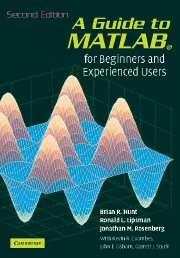Preface
Published online by Cambridge University Press: 05 September 2012
Summary
MATLAB is a high-level technical computing language and interactive environment for algorithm development, data visualization, data analysis, and numerical computation. Using MATLAB, you can solve technical computing problems faster than with traditional programming languages, such as C, C++, and Fortran. – The MathWorks, Inc.
That statement encapsulates the view of The MathWorks, Inc., the developer of MATLAB®. MATLAB 7 is an ambitious program. It contains hundreds of commands to do mathematics. You can use it to graph functions, solve equations, perform statistical tests, and much more. It is a high-level programming language that can communicate with its cousins, e.g., Fortran and C. You can produce sound and animate graphics. You can do simulations and modeling (especially if you have access not just to basic MATLAB but also to its accessory Simulink®). You can prepare materials for export to the World Wide Web. In addition, you can use MATLAB to combine mathematical computations with text and graphics in order to produce a polished, integrated, interactive document.
A program this sophisticated contains many features and options. There are literally hundreds of useful commands at your disposal. The MATLAB help documentation contains thousands of entries. The standard references, whether the MathWorks User's Guide for the product, or any of our competitors, contain a myriad of tables describing an endless stream of commands, options, and features that the user might be expected to learn or access.
- Type
- Chapter
- Information
- A Guide to MATLABFor Beginners and Experienced Users, pp. xi - xviPublisher: Cambridge University PressPrint publication year: 2006

